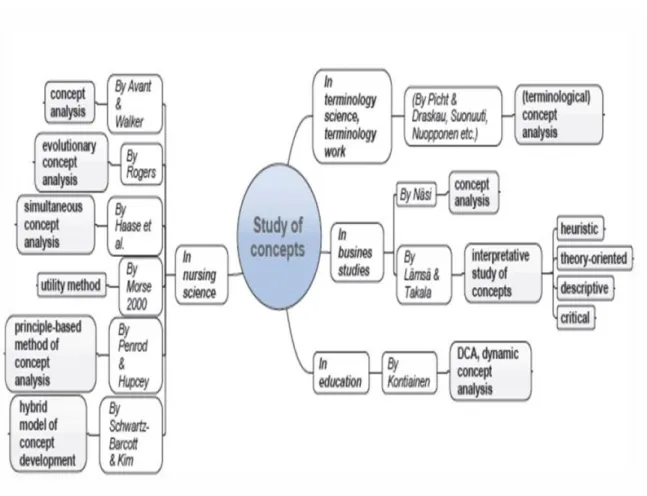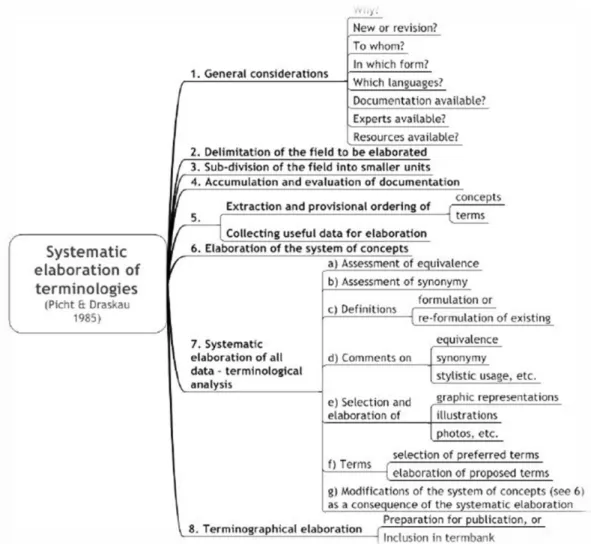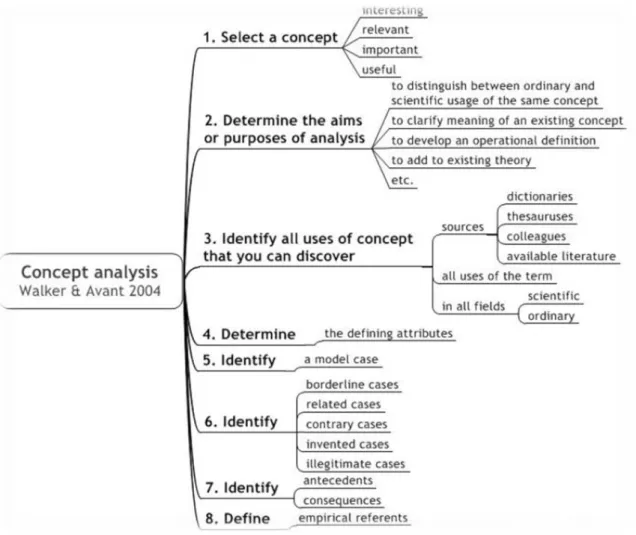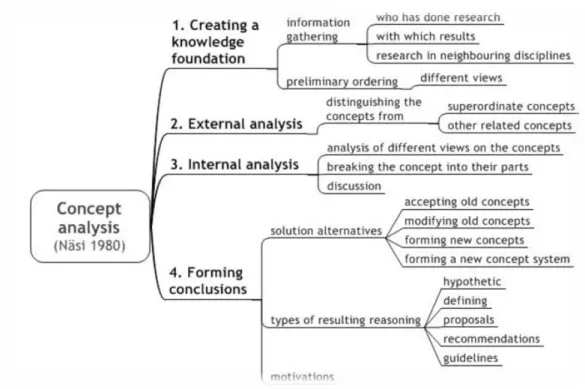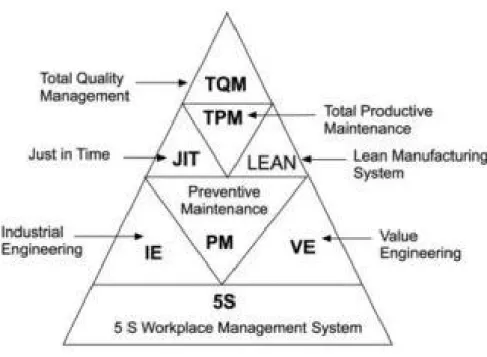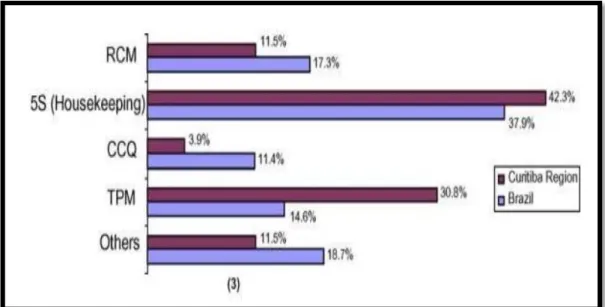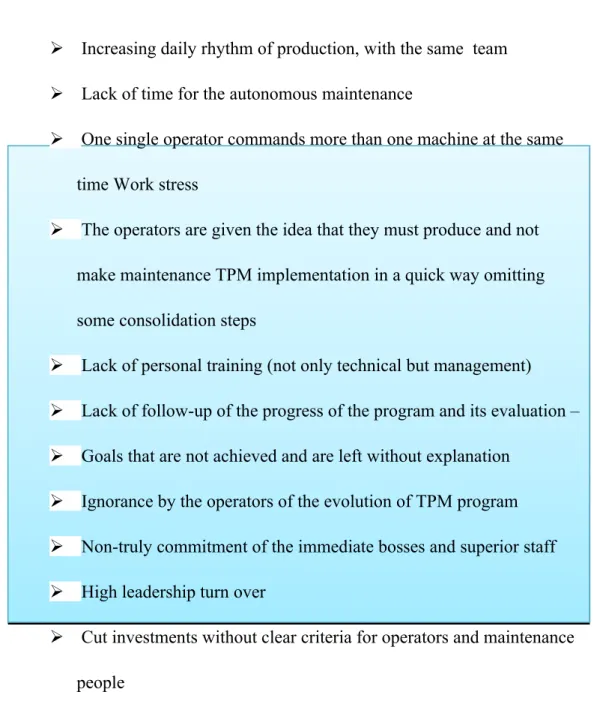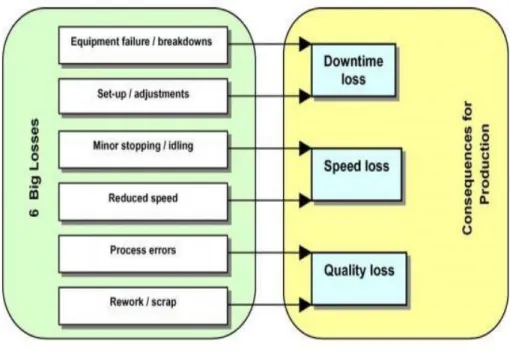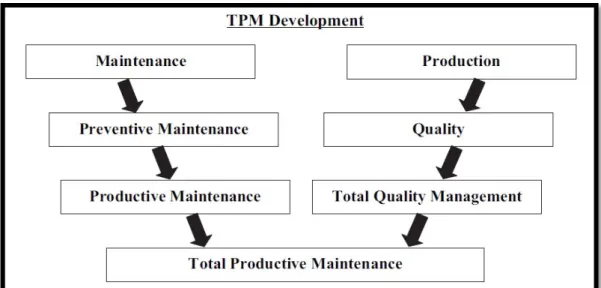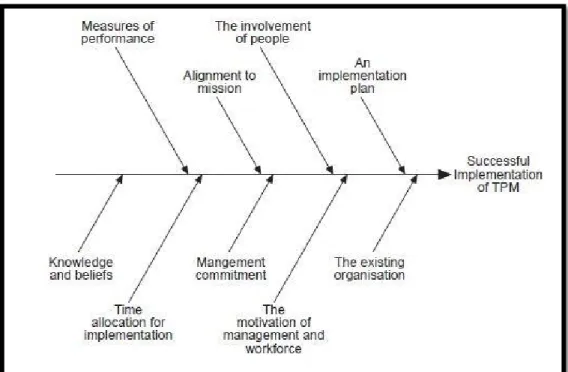CONCEPTUAL ANALYSIS OF TOTAL PRODUCTIVE MAINTENANCE (TPM) AND RELIABILITY
CENTERED MAINTENANCE (RCM)
By:
NOR AZIANTI BT AB AZID (Matrix no.: 125419)
Supervisor:
DR. HASNIDA AB SAMAT
May 2018
This dissertation is submitted to
Universiti Sains Malaysia As partial fulfillment of the requirement to graduate with an honors degree in
BACHELOR OF ENGINEERING
(MANUFACTURING ENGINEERING WITH MANAGEMENT)
School of Mechanical Engineering Engineering Campus Universiti Sains Malaysia
DECLARATIONS
This work has not previously been accepted in substance for any degree and is not being concurrently submitted in candidature for any degree.
Signed : ……….. (Nor Azianti Bt Ab Azid) Date : ………..
STATEMENT 1
This thesis is the result of my own investigations, except where otherwise stated.
Other sources are acknowledged by giving explicit references. Bibliography/
references are appended.
Signed : ……….. (Nor Azianti Bt Ab Azid) Date : ………..
STATEMENT 2
I hereby give consent for my thesis, to be available for photocopying and for interlibrary loan, and for the title and summary to be made available outside organizations.
Signed : ……….. (Nor Azianti Bt Ab Azid) Date : ………..
SUPERVISOR’S DECLARATION
I hereby declare that the preparation and presentation of this thesis were supervised in accordance with the guidelines on supervision of thesis laid down by Universiti Sains Malaysia.
Signed : ……….. (Dr. Hasnida Binti Ab Samat)
Date : ………..
i
ACKNOWLEDGEMENTS
I would like to acknowledge Allah, the Lord of the world for his bless and the following people who without their help this thesis would not have been possible.
Firstly, my deepest love is dedicated to my parents and all my siblings for their support throughout my Degree program.
Secondly, I would like to thank my project supervisor Dr. Hasnida Ab Samat, for all her help and encouragement over the duration of this project and your support is greatly appreciated.
I would also like to thank all my senior graduated from Universiti Sains Malaysia and all industrial peoples for responding to my survey form and supporting this project.
Finally, I would like to thank all my fellow friends for providing me with some very valuable advice throughout this thesis
NOR AZIANTI BINTI ABDUL AZID MEI 2018
TABLE OF CONTENTS
i i
Table of Contents
DECLARATIONS...i
ACKNOWLEDGEMENTS...ii
TABLE OF CONTENTS...iii
LIST OF FIGURES...v
LIST OF TABLES...vii
LIST OF ABBREVIATION...viii
ABSTRAK...ix
ABSTRACT...x
CHAPTER 1: INTRODUCTION...1
1.0 Overview...1
1.1 Total Productive Maintenance...1
1.2 Reliability Centered Maintenance...2
1.3 Project Background...3
1.4 Problem Statement...5
1.5 Objective...5
1.6 Scope of Project...6
1.7 Organization of the thesis...6
CHAPTER 2: LITERATURE REVIEW...8
1.0 Overview...8
2.1 Conceptual analysis...8
2.1.1 Systematic elaboration of terminologies...10
2.1.2 Walker and Avant's concept analysis model...11
2.1.3 Näsi's four elements of concept analysis...12
2.2 Total Productive Maintenance (TPM)...13
2.3 Reliability Centered Maintenance (RCM) ... 25
CHAPTER 3: METHODOLOGY ... 31
1.0 Overview ... 31
3.1 Conceptual Analysis Method ... 31
3.1.1 Element 1: Creating a knowledge foundation ... 32
3.1.2 Element 2: External analysis ... 32
iii
3.1.3 Element 3: Internal analysis ... 33
3.1.4 Element 4: Forming conclusions... 34
3.2 Survey Method ... 36
3.2.1 Steps of a Survey ... 37
3.2.2 Formulation of the Statement of Objectives ... 37
3.2.3 Selection of a Survey Frame ... 37
3.2.4 Determination of the Sample Design ... 38
3.2.5 Questionnaire Design ... 38
3.2.6 Data Collection Methods ... 38
3.2.7 Data Analysis ... 40
3.2.8 Documentation ... 40
CHAPTER 4: RESULT AND DISCUSSION ... 43
1.0 Overview ... 43
4.1 The result of conceptual analysis ... 43
4.1.1 Element 1 (creating a knowledge foundation ) ... 43
4.1.2 Element 2 (external analysis ) ... 47
4.1.3 Element 3 (internal analysis ) ... 68
4.1.4 Element 4 ( forming conclusion ) ... 71
4.2 The result of survey method ... 73
4.2.1 Quetionnaire sample ... 73
4.2.2 Questionnaire result ... 75
CHAPTER 5: CONCLUSION ... 82
5.1 Statement conclusion of Concetual Analysis ... 82
5.2 Statement conclusion of Survey ... 83
5.3 Future Work ... 85
REFERENCES ... 86
APPENDIX A ... 91 APPENDIX B ... 93
i v
LIST OF FIGURES
Figure 2.1: Various types of concept analysis methods(Nuopponen, 2010b) ...
9
Figure 2.2: A model of systematic elaboration of terminologies based on
Picht&Draskau (1985) ...
10
Figure 2.3 : Walker and Avant's concept analysis model(Nuopponen, 2010a) ...
11
Figure 2.4 : Näsi's concept analysis model(Nuopponen,
2010a) ... 12Figure 2.5 : The relationship between TPM and lean manufacturing
philosophies(Ahuja and Khamba, 2008a) ...
15
Figure 2.6: Eight pillars approach for TPM implementation (suggested by
JIPM).(Ahuja and Khamba, 2008a) ...
17
Figure 2.7: Management tools applied in the maintenance in companies in the Region of Curitiba and Brazil. Source: (Rodrigues and Hatakeyama,
2006)... 19Figure 2.8 : Factors that influence TPM failure. ... 20
Figure 2.9: The sources of losses according to TPM method. Source: adapted from (Rodrigues and Hatakeyama, 2006) ...
21
Figure 2.10: The relationship between both areas between maintenance and
production. (Patra, Tripathy and Choudhary, 2006) ...
22Figure 2.11 : Cause and effect diagram ± a generic model of factors affecting successful implementation of TPM (Gichoya, 2005) ...
23Figure 2.12 : Fault Tree illustrating the general failures in the lubrication and oil cooling system of the combined bearing. ... 29 Figure 2.13 : The implemented steps of
RCM. ... 30
Figure 3.1 : Näsi's four elements of concept analysis ...
31
Figure 3.2: Element 1 (creating a knowledge foundation)... 32
v
Figure 3.3: Flows in finding element 2 (external analysis)... 33 Figure 3.4 : Element 3 (internal analysis) ...
34
Figure 3.5 : Element 4 (forming conclusion) ...
34
Figure 3.6 : Overall process flow for Näsi's four elements of concept analysis. ...
35
Figure 3.7 : The phase of the survey ...
36
Figure 3.8 :The steps of survey method. ...
41
Figure 3.9 : Flowchart scope of the project ...
42
Figure 4.1 : The timeline of RCM and
TPM. ... 48Figure 4.2 :shows the tools of Lean manufacturing. ... 54Figure 4.3 : TPM consists of three basic goals; Zero product defects, Zero breakdowns, and Zero Accidents.
Furthermore, TPM has 12 activities coupled to the basic goals.
(GUSTAV FREDRIKSSON, 2012) ...
55
Figure 4.4 :shows the issues addressed by various TPM pillar initiatives ...
56
Figure 4.5: The four principles or key features that characterize the RCM process (Duffuaa and Ben-Daya, 2009) ...
57
Figure 4.6 : Common questions to establish a maintenance method. ...
58
Figure 4.7 : RCM approach, structured with worksheets. ...
59
Figure 4.8: Method for TPM implementation. (Ahmed, Hj. Hassan and Taha, 2004) 61 Figure 4.9 : Framework for TPM implementation and its benefits. ...
62
Figure 4.10 : Classification of TPM Award-winning Indian companies ...
63
Figure 4.11: Year-wise classification of papers on TPM for literature review... 63 Figure 4.12 : Sectors of TPM implementation ...
64
v i
Figure 4.13 : The equations involve to measure OEE. ...
64
Figure 4.14: RCM implementation view as a transforming process... 65 Figure 4.15 : Strategy framework of
RCM ... 66Figure 4.16: The three stages of failure rates that are usually experienced by a machine: infant mortality, normal or useful life, and end of life wear-out stage (Samat,
Kamaruddin and Azid, 2012) ...
67
Figure 4.17: Front page of the survey form. ...
74
Figure 4.18: Gender type. ...
75
Figure 4.19: Type of department...
75
Figure 4.20: Type of business involved ...
76
Figure 4.21: Type of maintenance strategies used in an organization. ...
77
Figure 4.22: Employees involvement in maintenance activities...
77
Figure 4.23: Safe work environment provided by top management ...
78
Figure 4.24: Management commitment to education and traning of employees. ...
79
Figure 4.25: Type of maintenance tools used in an organizations ...
79
Figure 4.26: Effectiveness ranking of maintenance strategies. ...
80
Figure 5.1: The relationship of TPM and RCM ...
84
LIST OF TABLES
Table 2.1: Manufacturing priorities and expectations from TPM effectiveness (Hooi
vii
and Leong, 2017) ...
18 Table 2.2: FMEA punctuation
form. ... 28
Table 4.1: Journals and Articles for Total Productive Maintenance (Tpm) ...
44
Table 4.2: Journals and Articles for Reliability Centered Maintenance (Rcm) ...
45
Table 4.3: Definitions of TPM from various literature ...
50
Table 4.4: Definitions of RCM from various literature. ...
51
Table 4.5: Standardized form for FMEA analysis. (Souza and Álvares, 2008) ...
60
Table 4.6: Conclusion table of all elements ...
71
v iii
LIST OF ABBREVIATION
BM Breakdown Maintenance CM Corrective Maintenance FFA Functional Failure Analysis
FFMEA Function, Failure Mode, and Effect Analysis FMEA Failure Mode and Effect Analysis
FMECA Failure Mode Effect and Criticality Analysis FSI Functionally Significant Item
JIT Just In Time
LMS Lean Manufacturing System OEE Overall Equipment Effectiveness OM Opportunistic Maintenance PdM Predictive Maintenance PM Preventive Maintenance
RCM Reliability Centered Maintenance
SWOT Strengths, Weaknesses, Opportunities and Threats TPM Total Productive Maintenance
TQM Total Quality Management VSM Value Stream Mapping
ix
ABSTRAK
Penyelenggaraan sebagai isu penting yang perlu ditangani semasa reka bentuk dan pembuatan atau pembinaan system. Strategi penyelenggaraan yang baik akan meningkatkan prestasi syarikat. Penyelenggaraan Total Produktif (TPM) adalah salah satu strategi penyelenggaraan yang terkenal yang digunakan secara meluas dalam organisasi. Pada masa yang sama, terdapat strategi penyelenggaraan lain yang digunakan oleh organisasi yang merupakan penyelenggaraan Reliabiliti Terpusat (RCM). TPM dan RCM mempunyai konsep dan prinsipnya sendiri sebagai strategi penyelenggaraan untuk memberi kesan kepada prestasi dan kebolehpercayaan sistem.
Oleh itu, dalam kajian ini, TPM akan dikaji dengan RCM untuk menunjukkan hubungan mereka. Berdasarkan analisis konseptual, penulis akan menganalisis penerbitan dari jurnal, buku, dan artikel untuk mencari semua maklumat berkaitan, seperti genealogi, definisi, konsep dan prinsip, dan pelaksanaan. Kaedah konseptual yang digunakan adalah empat unsur Näsi. Kajian ini juga menggunakan kaedah kaji selidik kaji selidik. Objektif kaji selidik ini adalah untuk mengkaji strategi penyelenggaraan semasa dalam industri sebenar dan untuk menghubungkannya dengan TPM dan RCM. Tinjauan ini telah dijawab melalui elektronik dan tinjauan dilakukan menggunakan aplikasi Google Forms. Pada akhir kajian ini, hasil kajian TPM dan RCM menunjukkan bahawa TPM bermula pada 1970 manakala RCM bermula pada tahun 1960-an, tetapi asas TPM dan RCM dimulakan pada tahun 1950an dengan penyelenggaraan Pemusnahan (BM). TPM pada dasarnya adalah tentang menghapuskan kerosakan melalui aktiviti sehari-hari yang melibatkan keseluruhan kerja tenaga manakala konsep RCM adalah untuk meningkatkan kebolehpercayaan peralatan. Objektif TPM adalah untuk mencapai kegagalan sifar, kecacatan sifar, dan sifar kemalangan manakala TPM adalah untuk memelihara fungsi. Walaupun keduaduanya menggunakan alat yang berbeza, kedua-duanya dikaitkan bersama melalui alat Lean. TPM kebanyakannya boleh dilaksanakan dalam industri besar manakala RCM boleh digunakan dalam industri saiz kecil atau sederhana. Kedua-duanya boleh meningkatkan kualiti produk, kebolehpercayaan peralatan, meningkatkan keselamatan, dan meningkatkan keuntungan. Dari hasil tinjauan, kebanyakan responden datang dari syarikat-syarikat yang melaksanakan penyelenggaraan tradisional (PM dan CM) daripada TPM dan RCM.
x
ABSTRACT
Maintenance is an important issue that needs to be addressed during the design and manufacturing or building of a system. A good maintenance strategy will increase the performance of the company. Total Productive Maintenance (TPM) is one of the famous maintenance strategies that are widely used within the organization. One maintenance strategy used by the organization which is a Reliability Centered Maintenance (RCM). Both TPM and RCM have its own concepts and principles as a maintenance strategy to give impact to the performance and reliability of the system.
Therefore, in this research, the TPM will be studied with RCM to show their relationship. Based on the conceptual analysis, the author will analyze publications from journals, books, and articles to find all related information, such as genealogy, definition, concepts, and principle, and implementation. The conceptual method used is Näsi's four elements of conceptual analysis. This research also used a questionnaire survey method. The objective of this survey is to study the current maintenance strategies in the real industries and to relate it to TPM and RCM. The survey has been answered through electronically and the survey is done using the application of Google Forms. At the end of this research, the result of the study of TPM and RCM shows that TPM started in 1970 while RCM started in the 1960s, but the foundation of TPM and RCM was started in 1950s with Breakdown Maintenance (BM). TPM basically is about elimination faults through day-to-day activities involving the entire force work while the concept of RCM is to improve equipment reliability. The objective of TPM is to achieve zero breakdowns, zero defects, and zero accidents while TPM is to preserve the functions. Although both using different tools both are linked together through the Lean tool. TPM mostly can be implemented in big plant industries while RCM can be applied in small or medium size plant. Both can increase product quality, equipment reliability, increase safety, and increase profit. From the survey result, most of the respondent comes from the companies that implementing tradisional maintenance (PM and CM) rather than TPM and RCM.
xi
CHAPTER 1: INTRODUCTION
1.0 Overview
This introduction will review some current Total Productive Maintenance (TPM) and Reliability centered maintenance (RCM) concept. It will provide a brief of geneology, definition, and the important of both maintenance process in the industry.
Next, the goal of the project, problem statement, the scope of the project and thesis outline also covered in this chapter to give some review about this whole research.
1.1 Total Productive Maintenance
Along with the decreasing expansion of technology and competition among industries, organizations employ different strategies and policies to increase productivity and decrease costs. Maintenance is one of a policy which is used to cut costs, increase productivity and to continue with the global competition. A lot of maintenance strategies have been developed over the years.
Maintenance plays an important role in the production system because it is a largest controllable cost and status quo represents a challenge for leading managements to re-evaluate their maintenance strategies and decision making work attempts to understand different maintenance policies making for better maintenance of assets. So, the efficiency of maintenance systems can effect the profit of a plant.
Therefore, selecting appropriate maintenance policies are vital for each manufacturing company. An organization can save the huge amount of time, money, and the useful resources in dealing with reliability, maintainability, and performances.
A company can use an innovative approach which is a Total Productive Maintenance (TPM) to maintenance and optimizes equipment efficiency, eliminates faults and promotes autonomous maintenance between operators, through day-to-day activities involving the entire force work. (Pinto, Pimentel and Cunha, 2016)
According to Nakajima (1988), as cited by Liselott (Maintenance, 2000), TPM is an approach that involves employees from the maintenance department and the production
1
departmentto equipment management. An autonomous maintenance by operators and small group activities in every department and at every level. All improvements should be standardised and maintained because TPM is continuous improvements focusing on the equipment and the production. The overall equipment effectiveness can increase by using the method of autonomous maintenance. This requires, among other things, a focus on the equipment's availability and reliability.
Best results will be achieved if TPM is implemented throughout the whole company, including the administrative departments. Then the connection to TQM, Total Quality Management is obvious. Like TQM, which is Quality Management on a company-wide basis, TPM is equipment maintenance performed on a company-wide basis (Nakajima, 1989). TPM combines organisation, management, quality, and maintenance philosophies.
According to The word "total" in "Total Productive Maintenance" has three meanings related to three important features of TPM (Nakajima, 1989) as cited by as cited by Liselott (Maintenance, 2000) which is the first one is the total effectiveness of predictive and productive maintenance. Second, total PM (Preventive Maintenance) which is maintenance prevention and activities to improve maintainability as well as preventive maintenance. Third, total participation through autonomous maintenance by operators and small group activities in every department and at every level. Then
"Productive Maintenance" mean Continuous improvement activities in every department and at every level.
1.2 Reliability Centered Maintenance
Maintenance concepts such as RCM have been successfully applied in the process industry to reduce unnecessary preventive maintenance actions and come up with a systematic and efficient maintenance plan. Reliability centered maintenance (RCM) is a most systematic and efficient process to address an overall programmatic approach to the optimization of plant and equipment maintenance. Maintenance needs of the process plants equipment can be better addressed with RCM approach. Failure mode and effect analysis help in identifying all possible failure cause with a specific
2
reference to the component of systems and sub-systems. RCM is a technique for prioritizing the maintenance strategy in a systematic and logical manner. The primary objective of RCM is to preserve functions. (Chopra, Sachdeva and Bhardwaj, 2014)
RCM can be defined as a logical and structural process for developing or optimizing the maintenance requirements of a physical resource in its operating context to realize the level of reliability which can be achieved with an effective maintenance program. RCM is a maintenance strategy process to determine the maintenance requirements of any physical asset by identifying the functions of the assetin its operating context, the factor of failures and the effects of the failures.
1.3 Project Background
This project focus on a conceptual analysis of Total Productive Maintenance (TPM) And Reliability Centered Maintenance (RCM). Maintenance is always considered a subject of great concern when a newcomer industry or a fledgling production company is established. The reason lies in the significant role that maintenance plays in the industry’s profitability or the company’s productivity. A properly managed and well-organized maintenance plan will have a major influence on the system technical behavior (e.g., from reliability and security perspectives). It consequently results in increasing component’s useful lifetimes and assures their maximum achievable availabilities. (Dehghanian et al., 2013b)
Nowadays, companies have to meet competition from all over the world.
Worldwide competition is dependent, among other things, on deregulation, technical development, increased global trading, internationalization, and new principles for organization and management. The global market incorporates a wide spectrum of different customers with different cultures, needs, requirements, and expectations.
This implies that companies with global markets have to be prepared to meet the increasing demands from different customers and different societies.
In order, to be successful and to achieve world-class-manufacturing, organizations must possess both efficient maintenance and effective manufacturing
3
strategies. To compete with the challenges of increased competition and to survive in the market, all company have to work continuously with improvements to improve and maintain their business and thereby strengthen their competitiveness.
Manufacturing companies, need to work hard towards the need for an increase in production from existing plants, improve product quality, eliminate all unnecessary activity, shorter and more stable through-put times, reductions in the amount of tiedup-capital, shorter batch sizes, investments in advanced manufacturing technologies and an emphasis on safety and environmental issues.
This means cutting manufacturing costs and finding methods and tools to improve efficiency and principles in the management of the organisation. Several philosophies or concepts have been developed to meet the requirements of manufacturing plants. This thesis will focus on two of these concepts, namely TPM and RCM. Both of this concept has its own function in the maintenance system. The history, definition, concepts and principle, and implementation of TPM and RCM is an interesting issue to be studied to find out the relationship between this two concepts.
The relationship between TPM and RCM will help organisations to simplify the process of implementing TPM and RCM. The analysis of these findings will form the basis for recommendations and guidance for organisations, which intend to implement both TPM and RCM. So, the success implementation of both maintenance can be achieved.
4
1.4 Problem Statement
Equipment reliability problem and less efficient management of plant assets gave a big impact on the organization and can increase the production cost. Most organizations today having a big problem with deciding the best methods and tools to improve efficiency and principles in the maintenance management of the organization.
Many theories about Total Productive Maintenance and Reliability Centered Maintenance have been developed and published in different term and view according to the concept used in their research. TPM is an imperative technology in the industry of maintenance field to reduce operational and maintenance costs while RCM is a maintenance strategy to improve the productivity and reliability of an organization.
Therefore, this thesis used conceptual analysis to discuss the relation between TPM and RCM wherether TPM have the same approach with RCM or not. Aiming for recommendations and guidance for organisations, which intend to implement both TPM and RCM into an admirable world class manufacturing facility.
1.5 Objective
The objectives of this research are:
1. To study the conceptual analysis of Total Productive Maintenance (TPM) And Reliability Centered Maintenance (RCM).
2. To investigate the similarity and the differentation Total Productive Maintenance (TPM) And Reliability Centered Maintenance (RCM).
5
1.6 Scope of Project
In order to success this project, a clear scope of the project must be well defined.
Without a clear and proper scope of the project, the problem will arise and new possibilities will come up. This problem will drag on and wasting time. A conceptual analysis based on the study that had been done by Anita Nuopponen (2010) that consist of three models analysis which is a systematic elaboration of terminologies, Näsi's four elements of concept analysis and Walker and Avant’s concept analysis model has been studied. This thesis used the Näsi's four elements of concept analysis to find the relationship between Total Productive Maintenance and Reliability Centered Maintenance. This conceptual analysis has been limited to focus on acedemic website, journals, articles and books only. A questionnaire survey technique has been developed in the present study for seeking information and establishing the relationship of TPM and RCM. The structured questionaire was sent to manufacturing companies around Pulau Pinang for obtaining the information on the topic in real industry situation.
1.7 Organization of the thesis
This thesis is about Conceptual Analysis of Total Productive Maintenance (TPM) And Reliability Centered Maintenance (RCM) and consists of five chapters.
The first chapter gives an outline of the whole thesis which covers both explanations of TPM and RCM. Next, the goal of the project, problem statement, the scope of the project and thesis outline also covered in this chapter.
Chapter two presents the literature review based on previous researches and studies conducted on Total Productive Maintenance (TPM) And Reliability Centered Maintenance (RCM). Detail explanation about background, concept, and princple, implementation plan and limitations of TPM and RCM are described in this chapter.
This literature review has been limited to focus on acedemic website, journals, articles and books only as references.
Chapter three review on the methodology used throughout the project. This chapter provides a few suggestions method for conceptual analysis and also provides the details about Näsi's four elements of concept analysis. Other than that, this chapter
6
also explains the method used for questionnaire survey technique in the present study for seeking information and establishing the relationship of TPM and RCM in the real industry. The flow process to conduct Näsi's four elements and survey method are provided in this chapter.
Chapter four comprises of results and discussions of this thesis. Geneology, definition, concept and tools, implementation plan and limitations for both will be discussed in this chapter. The relationship between TPM and RCM will be stated in this chapter. The overall result of the relation of TPM and RCM will be verified here.
Lastly, chapter five provides a final conclusion for this project. A summary of the results obtained in chapter four will be concluded in this chapter. Besides, recommendations for future works also discussed.
CHAPTER 2: LITERATURE REVIEW
1.0 Overview
In this chapter, the literature review based on previous researches and studies conducted on conceptual analysis method, Total Productive Maintenance (TPM) And
7
Reliability Centered Maintenance (RCM) are reviewed. Explanation of background, concept, and princple, implementation plan and limitations of TPM and RCM are described in this chapter. This literature review has been limited to focus on acedemic website, journals, articles and books only as references. The conceptual analysis will be used to show the relationship of TPM and RCM.
2.1 Conceptual analysis
This thesis is using conceptual analysis method as the method to study the to study about Total Productive Maintenance (TPM) And Reliability Centered Maintenance (RCM). Conceptual analysis is a method to understand the meaning of an idea or concept and to determine how that idea or concept relates to other philosophical problems.
Although the philosophers primarily used the conceptual analysis with regard to abstract ideas, this type of analysis is highly importance for all other academic disciplines. Firstly, precise the definition and foremost necessary in the analysis of any idea or concept, before any investigation into its meaning and relationship to other ideas and concepts. This will generate understanding and the expansion of knowledge for any subject area. Understanding philosophical concepts are paramount to understanding religion, the arts, and the natural and social sciences. This paper is using the conceptual analysis as the main method to study the concept of TPM and RCM.
Conceptual analysis is one of the main traditional methods of philosophy, arguably dating back to Plato's early dialogues. This methodology goes back to the time of Plato and has been the major methodology used by philosophers since then. A good example of this is in Plato’s Republic, where he analyzes the concept of justice in context to the ideal state.
Anita Nuopponen stated that the conceptual analysis could be basically defined as an activity where it concepts, characteristics, and relations to other concepts is clarified as an activity. Conceptual clarity is of great importance for all kinds of research creation. General research guidelines, as well as philosophical literature, often mention concept analysis or concept research.(Nuopponen, 2010a)
8
There are many methods for conceptual analysis as search results texts on terminological research and terminology work, nursing science and educational studies and studies from business as well as formal concept analysis. Figure 2.1 shows the varius type of conceptual analysis. (Nuopponen, 2010b)
Figure 2.1: Various types of concept analysis methods(Nuopponen, 2010b)
Here are the common methods used in a conceptual analysis published by Anita Nuopponen in 2010: (Nuopponen, 2010a)
2.1.1 Systematic elaboration of terminologies
Terminological textbooks normally describe the basic elements of the theory as well as theprocess of terminology work or terminology projects. Concept analysis is normally an integrated inseparable element of the process and rarely even mentioned
9
as a separate step. A model of systematic elaboration of terminologies based on Picht&Draskau (1985) as shown in Figure 2.2.
Figure 2.2: A model of systematic elaboration of terminologies based on Picht&Draskau (1985)
2.1.2 Walker and Avant's concept analysis model
Walker and Avant's concept analysis is widely used in nursing science, various authors describe very detailed processes. Here, the process model by Walker and Avant (1994) is presented, because it seems to be the most influential model in nursing science. Figure 2.3 shows the Walker and Avant's concept analysis, model.
10
Figure 2.3: Walker and Avant's concept analysis model(Nuopponen, 2010a)
2.1.3 Näsi's four elements of concept analysis
Concept analysis for Näsi (1980) means "target-oriented solving of conceptual problems; forming concepts through analytic and synthetic reasoning by using existing concepts and insight". Näsi's concept analysis model as given in Figure 2.4.
11
Figure 2.4: Näsi's concept analysis model(Nuopponen, 2010a)
A Näsi's four elements of concept analysis published by Anita Nuopponenis used in this thesis as a conceptual analysis method used to study the conceptual analysis of Total Productive Maintenance (TPM) And Reliability Centered Maintenance (RCM) and to investigate the similarity and the differentation Total Productive Maintenance (TPM) And Reliability Centered Maintenance (RCM).
2.2 Total Productive Maintenance (TPM)
Within last 50 years, the field of maintenance and reliability engineering has emerged mainly. This field has made strides in the last few decades and continues to have the potential to design additional growth to improve the effectiveness of manufacturing system. Many theories have been developed in the last 5 decades but the two most
12
influential ones are RCM (reliability centered maintenance) developed in the 1970’s in the US aviation sector, and, TPM (total productive maintenance), which emerged from Japan’s automotive sector. (Hung Hong and Winston IP, 2006)
Ahuja and Khamba (2008), studied the literature on Total Productive Maintenance (TPM) and to present an overview of TPM implementation practices adopted by the manufacturing organizations. Both of them also highlighted the appropriate enablers and success factors for eliminating barriers to successful TPM implementation. They defined TPM is a unique Japanese philosophy, which has been developed based on the Productive Maintenance methodologies and concepts. M/s Nippon Denso Co. Ltd, a supplier of M/s Toyota Motor Company, Japan in the year 1971 introduced concept of TPM based on Productive Maintenance concepts and methodologies. Total Productive Maintenance play importantat role to maintenance that optimizes equipment effectiveness, eliminates breakdowns and promotes autonomous maintenance by operators through day-to-day activities involving total workforce. (Ahuja and Khamba, 2008a)
TPM is a strategic approach to increase the performance of maintenance system if it is effectively adapt and implement in the manufacturing organizations.
TPM brings maintenance into focus as a necessary and vitally important part of the business through the involvement of everybody in the organisation. The TPM initiative is targeted to enhance thecompetitiveness of organizations and it encompasses a powerful structured approach to change the mind-set of employees there by making a visible change in the work culture of an organization because the employee commitment is a key factor to implement the TPM process. Fully of employee commitment from all levels and function in an organization can maximize the overall effectiveness of production equipment.
TPM aims to eliminate breakdowns, promotes maintenance autonomy involving total workforce and optimise the equipment effectiveness. It is total maintenance strategy that covers maintenance prevention, improvement related maintenance, and preventive maintenance with the ultimate goal of preventing losses and waste during the manufacturing process. It also promotes a system in whichoperators develop “ownership” of their machines area, learns much more about them, and in the process realize skilled trades to concentrate on problem diagnostic
13
and equipment improvement projects. TPM is not a maintenance specific policy, it is a culture, a philosophy and a new attitude towards maintenance for enhancing manufacturing performance through the improved of the production system.
TPM has been depicted as a manufacturing strategy comprising of following steps:
(Ahuja and Khamba, 2008a)
• maximizing equipment effectiveness through optimization of equipment availability, performance, efficiency and product quality.
• establishing a preventive maintenance strategy for the entire life cycle of equipment.
• covering all departments such as planning, user, and maintenance departments.
• involving all staff members from top management to shop-floor workers.
• promoting improved maintenance through small-group autonomous activities.
Sekine and Arai (1998) as cited by Ahuja and Khamba (2008) stated TPM is one of the methodology originating from Japan to support its lean manufacturing system. This occurs as, effective and dependable equipment, are essential prerequisite for implementing Lean manufacturing initiatives in the organizations. While Total Quality Management (TQM) and Just-In-Time (JIT) programs have been around for a while, the manufacturing organizations off late, have been putting in enough confidence upon the latest strategic quality maintenance tool as TPM. The relationship between TPM and lean manufacturing philosophies as depicted in Figure 2.5.
14
Figure 2.5: The relationship between TPM and lean manufacturing philosophies(Ahuja and Khamba, 2008a)
In Figure 2.1, it is clearly revealed, that TPM is the corner stone approaches for most of the lean manufacturing philosophies and can contribute towards the success of lean manufacturing. The authors defined that TPM is a production-driven improvement methodology that is designed to ensure efficient management of plant assets and optimize equipment reliability as cited by Robinson and Ginder, (1995).
In a recent study by (Ab-Samat et al., 2012), their study is about Implementation of Autonomous Maintenance in Semiconductor Industry (a case study). This study aimed to investigate the performance of maintenance system in a company by identifying the critical machine with the highest breakdown time and frequency. It was found that high breakdown was due to the high workload of technicians, where technicians do not have enough support in performing the maintenance task. In this paper, the authors suggested Autonomous Maintenance
(AM) program to reduce technicians’ workload through operators’ involvement.
The authors defined AM as a program encourages the transfer of responsibilities from the maintenance staff to the operators. The implementation of this AM will also
15
include in Eight pillars of TPM and this Autonomous Maintenance help in reducing technician’workload. According to this paper, the tasks of operators are:
• Maintain basic machine conditions like lubricating, cleaning, and bolting.
• Maintain operating conditions by conducting the proper operation and visual inspection.
• Discover machine’s deterioration mainly through visual inspection and early identification of sign abnormalities during operation
• Enhance skills such as about machine operation, adjustment, set-up, and also visual inspection.
TPM is a change in philosophy, which has contributed significantly towards the realization of significant improvements in the manufacturing organizations in the West and Japan as cited by Maggard and Rhyne (1992). TPM also has been depicted as a manufacturing strategy to maximizing equipment effectiveness through optimization of equipment efficiency, availability, performance, and product quality.
TPM has it own basic practices are often called the pillars or elements of TPM.
The pillars TPM paves way for excellent planning, organizing, monitoring and controlling practices through its unique eight-pillar methodology. The eight pillar implementation plan canresult in areduction in maintenance costs, reduced production stoppages and downtimes, and asubstantial increase in labor productivity. The eight TPM pillars are as depicted in Figure 2.6 (Ahuja and Khamba, 2008a).
16
Figure 2.6: Eight pillars approach for TPM implementation (suggested by JIPM).(Ahuja and Khamba, 2008a)
There is one study that had been done by Hooi and Leong in 2017, discussed total productive maintenance (TPM) and its relationship with manufacturing performance improvement in the Malaysian manufacturing sector. Manufacturing production driven improvement methodology, specifically, total productive maintenance (TPM), has been defined as a new manufacturing paradigm that has gone through a rapid but steady evolution in Japan. The authors stated that TPM is a total employee involvement (involves everybody in the organisation) and it proactively provides comprehensive maintenance for all productive equipment daily throughout its life.
In this article also stated that TPM approach can eliminate breakdowns, promotes maintenance autonomy involving total workforce and optimises equipment effectiveness. It is a total maintenance system that covers preventive maintenance, maintenance prevention, and improvement related maintenance, with the ultimate goal of preventing losses and waste.
This research has shown that TPM has a direct impact on improving the overall production equipment performance. TPM implementation success not only improves the effectiveness of the manufacturing system and equipment efficiency but also bring improvement in the overall manufacturing performance indicators such as improvement inreduction in customers’ complaints, employees’ morale and job satisfaction, reduction in cycle time and WIP. (Hooi and Leong, 2017)
The authors discussed that TPM is a synergistic collaborative approach that stimulates continuous improvement (Kaizen) in manufacturing to capacity assurance and safety, enhance product quality and operational efficiency. TPM implementation is a long process as it requires gradual changes in the organisation culture and employees’
attitude before an organisation is able to adopt and accept the best. Manufacturing priorities and expectations from TPM effectiveness list provided in Table 2.1.
Table 2.1: Manufacturing priorities and expectations from TPM effectiveness (Hooi
17
and Leong, 2017)
In the study of Analysis of the fall of TPM in companies by Rodrigues and Hatakeyama (2006), the authors discussed main factors involved in the failure of TPM.
The information ground for the elaboration of this paper is mainly formed by the manufacturing industries of the Metropolitan Region of Curitiba because. TPM is presented in the companies as one of the main tools of management of the industrial maintenance. Figure 2.7 shows the result from the study about the Management tools applied in the maintenance in companies in the Region of Curitiba and Brazil.
18
Figure 2.7: Management tools applied in the maintenance in companies in the Region of Curitiba and Brazil. Source: (Rodrigues and Hatakeyama, 2006)
The focus of the proposed work in TPM methodology is the human being by closely connected to the way of managing people. So, it is necessary to create indicators for the evaluation of performance indicators of the TPM. In this study, the authors discussed the type of indicators used to verify and control TPM. The indicator performance discussed is Costs (Supply, levels, and circulation), Quality ( achieve zero defects), Safety(almost total eliminating of violations), and Morale (suggestions, and participation of all employees in the small group meetings).
Even with these indicators, in a certain case, it is constructed in the companies only to satisfy the audit process (internal and external). With this attitude, one ends up with a superficial management of the whole process, where the manager does not get the benefits that a real interaction between production and maintenance offered by TPM. In other words, the low of commitment by managers leads to ruining the already established structure. Figure 2.8 shows the main factors that directly influence the fall in TPM pattern inside companies indicated by the production and maintenance people.
19
Increasing daily rhythm of production, with the same team
Lack of time for the autonomous maintenance
One single operator commands more than one machine at the same time Work stress
The operators are given the idea that they must produce and not make maintenance TPM implementation in a quick way omitting some consolidation steps
Lack of personal training (not only technical but management)
Lack of follow-up of the progress of the program and its evaluation –
Goals that are not achieved and are left without explanation
Ignorance by the operators of the evolution of TPM program
Non-truly commitment of the immediate bosses and superior staff
High leadership turn over
Cut investments without clear criteria for operators and maintenance people
Figure 2.8: Factors that influence TPM failure
.
The research for interaction between production and maintenance has been of great intensity in the manufacturing industries and it is possible to enhance the productivity in a global way. The growth of companies uses new technologies and new methods of management keep increasing to broad their space in the market. The conception of TPM was an answer to the demands of a competitive market that obliged the companies to draw some attitudes, such as reducing interruptions or stops of production (breakdowns or interventions), eliminating waste, always obtaining the
20
best performance of the equipment and redefining goals. TPM distinguishes and attacks six essential sources of diminishing output in the industrial installations, which are presented in Figure 2.9.
Figure 2.9: The sources of losses according to TPM method. Source: adapted from (Rodrigues and Hatakeyama, 2006)
Based on the study done by Patra, Tripathy, and Choudhary (2006) discussed that TPM is a new philosophy of teamwork and continuous improvement. The authors also highlighted TPM is a program for the fundamental improvement of maintenance functions in an organization, which involves its entire employees. TPM was originally developed by the Japanese from the preventive maintenance (PM) strategies used in the United State over 30 years ago.The TPM program goal is to increase production and improve employees’ moral and job satisfaction.
Therefore, in today’s market driven economy it is vital for organizations to adopt TPM as a method which helps facilitate continuous improvement in services and this is one of the keys to staying competitive throughout the organization and supply network. In the continuous improvement process, it is not the rate that is
21
important but the momentum that matters. This means that it does not matter how small matter or simple is that organizations are, what matter is that organization brings some kind of improvement in the organization.
In maintenance areas, most of the authors described preventive maintenance and productive maintenanceas as the well-developed activities. Similarly, in production areas, the already developed parts are quality and total quality management (TQM). But in a fully developed of TPM implementation, as envisaged by the Japanese, the relationship between both areas between maintenance and production shown in Figure 2.10.
Figure 2.10: The relationship between both areas between maintenance and production. (Patra, Tripathy and Choudhary, 2006)
There are many definitions discussed by the authors based on their research about TPM. In 2005, the author (Gichoya, 2005) presented a comprehensive review of TPM literature from which he described TPM as the Japanese approach. He defined TPM in five terms which is It aims at getting the overall efficient use of equipment, It involves every employee from top management down, it establishes a total PM system
22
encompassing maintenance prevention and improvement related maintenance, It promotes and implements PM based on autonomous, small group activities, and It requires the participation of maintenance department workers, equipment designers, and equipment operators.
In this paper, the author also discussed the factors involved in successful implementation of TPM in the UK based on a review of a case study on manufacturing organization’s efforts to implement TPM. Figure 2.11 shows the Cause and effect diagram generic model of factors affecting successful implementation of TPM.
Figure 2.11: Cause and effect diagram ± a generic model of factors affecting successful implementation of TPM (Gichoya, 2005)
In a recent study by (Mwanza and Mbohwa, 2015), both of them defined TPM is a productivity improvement activites analogous to the use of total quality management (TQM), while also described it as a Japanese concept of equipment management that
23
allows involvement of all employees to improve decisively the equipment performance in the manufacturing area. They also analysed the TPM into three words:
• Total: Involvement all the employees from top to bottom management.
• Productive: This means no wasted activity or the production of goods and services that exceed customer’s expectation.
• Maintenance: keeping plant and equipment in good working order.
The authors also stated that TPM is designed to improve overall efficiency or maximize equipment effectiveness by establishing a comprehensive productive maintenance system with the participation of all employees from top management down to shop-floor workers, covering the entire life of the equipment, spanning all equipment related fields such as planning and maintenance and promote productive maintenance through voluntary and motivation management small group activities.
While in the study of Total productive maintenance (TPM) as a tool for improving productivity by author (Morales Méndez and Rodriguez, 2017), the authors discussed (TPM) philosophy as a systematic means for increasing productivity and avoiding losses in an autoparts machining line. The increasing productivity and avoiding losses achieved by strategically implementing the Eight pillars of TPM on the basis of failure data, then “root cause analysis” performs for targeted improvement.
The authors satated that the contribution of TPM to the improvement of the productivity of the organization has been well recognized since the “Japan Institute of Plant Maintenance (JIPM)” introduced it to the industrial community as a way of eliminating the six big losses such as machine breakdowns, rework, process errors, reduced speed, idling at work station, and adjustmens. The company management has
24
